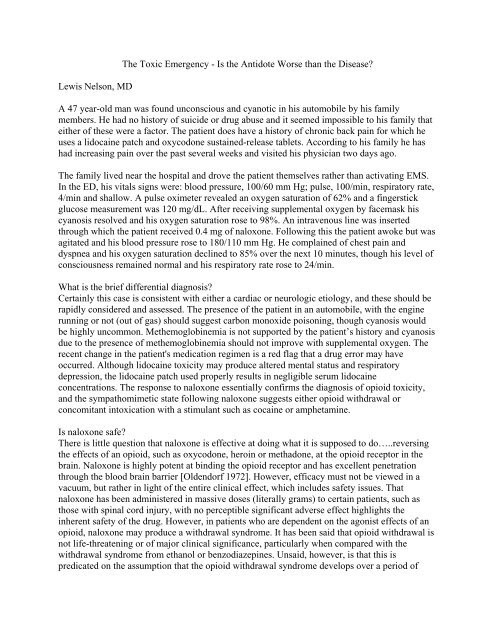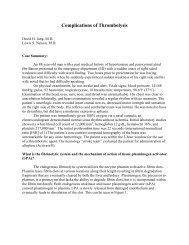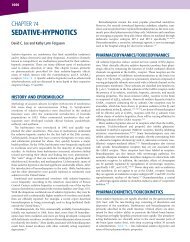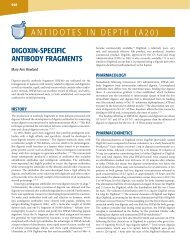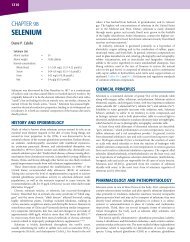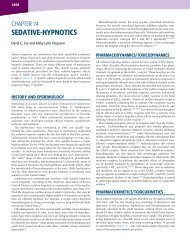Oxycodone and Naloxone
Oxycodone and Naloxone
Oxycodone and Naloxone
Create successful ePaper yourself
Turn your PDF publications into a flip-book with our unique Google optimized e-Paper software.
Lewis Nelson, MDThe Toxic Emergency - Is the Antidote Worse than the Disease?A 47 year-old man was found unconscious <strong>and</strong> cyanotic in his automobile by his familymembers. He had no history of suicide or drug abuse <strong>and</strong> it seemed impossible to his family thateither of these were a factor. The patient does have a history of chronic back pain for which heuses a lidocaine patch <strong>and</strong> oxycodone sustained-release tablets. According to his family he hashad increasing pain over the past several weeks <strong>and</strong> visited his physician two days ago.The family lived near the hospital <strong>and</strong> drove the patient themselves rather than activating EMS.In the ED, his vitals signs were: blood pressure, 100/60 mm Hg; pulse, 100/min, respiratory rate,4/min <strong>and</strong> shallow. A pulse oximeter revealed an oxygen saturation of 62% <strong>and</strong> a fingerstickglucose measurement was 120 mg/dL. After receiving supplemental oxygen by facemask hiscyanosis resolved <strong>and</strong> his oxygen saturation rose to 98%. An intravenous line was insertedthrough which the patient received 0.4 mg of naloxone. Following this the patient awoke but wasagitated <strong>and</strong> his blood pressure rose to 180/110 mm Hg. He complained of chest pain <strong>and</strong>dyspnea <strong>and</strong> his oxygen saturation declined to 85% over the next 10 minutes, though his level ofconsciousness remained normal <strong>and</strong> his respiratory rate rose to 24/min.What is the brief differential diagnosis?Certainly this case is consistent with either a cardiac or neurologic etiology, <strong>and</strong> these should berapidly considered <strong>and</strong> assessed. The presence of the patient in an automobile, with the enginerunning or not (out of gas) should suggest carbon monoxide poisoning, though cyanosis wouldbe highly uncommon. Methemoglobinemia is not supported by the patient’s history <strong>and</strong> cyanosisdue to the presence of methemoglobinemia should not improve with supplemental oxygen. Therecent change in the patient's medication regimen is a red flag that a drug error may haveoccurred. Although lidocaine toxicity may produce altered mental status <strong>and</strong> respiratorydepression, the lidocaine patch used properly results in negligible serum lidocaineconcentrations. The response to naloxone essentially confirms the diagnosis of opioid toxicity,<strong>and</strong> the sympathomimetic state following naloxone suggests either opioid withdrawal orconcomitant intoxication with a stimulant such as cocaine or amphetamine.Is naloxone safe?There is little question that naloxone is effective at doing what it is supposed to do…..reversingthe effects of an opioid, such as oxycodone, heroin or methadone, at the opioid receptor in thebrain. <strong>Naloxone</strong> is highly potent at binding the opioid receptor <strong>and</strong> has excellent penetrationthrough the blood brain barrier [Oldendorf 1972]. However, efficacy must not be viewed in avacuum, but rather in light of the entire clinical effect, which includes safety issues. Thatnaloxone has been administered in massive doses (literally grams) to certain patients, such asthose with spinal cord injury, with no perceptible significant adverse effect highlights theinherent safety of the drug. However, in patients who are dependent on the agonist effects of anopioid, naloxone may produce a withdrawal syndrome. It has been said that opioid withdrawal isnot life-threatening or of major clinical significance, particularly when compared with thewithdrawal syndrome from ethanol or benzodiazepines. Unsaid, however, is that this ispredicated on the assumption that the opioid withdrawal syndrome develops over a period of
time (e.g., from lack of access to drug) rather than instantly. The administration of naloxone toan opioid tolerant person results in precipitous opioid withdrawal, the effects of which are indeedpotentially life threatening.Precipitated opioid withdrawal which is sometimes intentionally done in an attempt atdetoxification (termed rapid opioid detoxification, or ultra-rapid opioid detoxification ifperformed under anesthesia) results in an exaggerated withdrawal response. [Kienbaum 2002]Delirium may develop. Massive catecholamine release from the autonomic nervous systemresults in hypertension, tachycardia, <strong>and</strong> cardiovascular sequelae such as pulmonary edema. Inthis setting, pulmonary edema may be functionally equivalent to “neurogenic” pulmonaryedema, often described in patients with critical head trauma. Though typically mild <strong>and</strong> shortlived, opioid-associated pulmonary edema may be life threatening, <strong>and</strong> it is highly associatedwith naloxone administration.[Buajordet 2004; Sterrett 2003; Sporer 2001]In the substance abusing population, polysubstance misuse raises the risk profile of naloxone.That is, failure to awaken following naloxone in an opioid dependent patient may represent not afailure of naloxone but the presence of a concomitant substance, such as a benzodiazepine,tricyclic antidepressant or ethanol. Since vomiting is common in patients with precipitated (<strong>and</strong>natural) opioid withdrawal, the failure to awaken raises the concern for pulmonary aspiration.Furthermore, in patients with concomitant stimulant use, abrupt reversal of the sedative effect ofan opioid may results in acute stimulant toxicity.How can the safety of naloxone be improved?Crucial in the underst<strong>and</strong>ing of opioid poisoning is that if naloxone disappeared today, noadditional acutely opioid-poisoned persons would likely die unnecessarily. Opioids producenearly all of their clinical morbidity by reducing the sensitivity of the brain’s respiratory centerto hypercarbia. This slows the patient’s respiratory depth <strong>and</strong> rate. Simply by providingventilatory support <strong>and</strong> supplemental oxygen, death should be readily preventable. Bag-valvemaskventilation is generally sufficient to provide the requisite minutes for naloxone to becomeeffective. Interestingly, the degree of catecholamine release is related to the degree ofhypercarbia at the time of naloxone administration, suggesting that simply ventilating someoneprior to naloxone administration may improve its safety.[Mills 1990]The administration of naloxone remains desirable for several reasons. Since there is no practicaldiagnostic test for opioid poisoning, an appropriate response to naloxone serves in a diagnosticrole. Even if the diagnosis of opioid poisoning is certain, prolonged BVM ventilation is laborintensive role <strong>and</strong> endotracheal intubation for mechanical ventilation is sometimes overkill. Thusnaloxone plays a key role in the clinical management of patient who are likely to be opioidpoisoned.<strong>Naloxone</strong>’s safety can be enhanced through titrated administration in divided doses to reach atotal dose rather than in empiric bolus fashion. The typical dose of 0.4 mg or 2 mg that is oftensuggested is probably unnecessarily large <strong>and</strong> the onset too rapid. A preferred method is toadminister naloxone in 40-50 μg (0.04 – 0.05 mg) aliquots; most patients respond appropriately,albeit more slowly. In concept, giving the drug slowly in small doses mimics the natural
withdrawal process <strong>and</strong> avoids precipitated withdrawal. The anesthesiology literature supportsthe effectiveness of this regimen, admittedly in a different patient population than is cared for inthe emergency department. Notwithst<strong>and</strong>ing this, the clinical pharmacology of naloxone supportsthis use with the caveat that it may take longer to reach the desired clinical endpoint. Patientswho require prolonged naloxone administration may receive a continuous infusion atapproximately 2/3 of the dose hourly that was required for initial reversal of sedation. Theendpoint of naloxone administration is spontaneous ventilation, not withdrawal!Clinical relevance of clinical pharmacology?In an effort to avoid the risk of intravenous catheter placement, naloxone may be administered byalternative (e.g., subcutaneous) routes. Although subcutaneous administration intuitively seemslike it would allow more rapid reversal than starting an intravenous line for administration, whenall delays are considered, the use of naloxone via the subcutaneous route <strong>and</strong> the intravenousroute are comparable. [Wanger 1998] An advantage of the subcutaneous route is theminimalization of precipitated opioid withdrawal due to the slow drug absorption phase, but thiscomes at the expense of easy titratability which may lead to a greater likelihood of over-reversal.Other routes, such as intranasal or nebulized, seem too difficult to titrate, <strong>and</strong> while they may beeffective, their safety is largely unstudied.Also of importance is the offset of clinical effect of naloxone. When administered intravenously,naloxone’s effect is expected to persist for approximately 40 minutes. Administeredsubcutaneously, its effects may persist slightly longer due to prolonged absorption. Since manyopioids, particularly methadone, have clinical duration far in excess of that of naloxone,observation for at least several hours seems warranted after reversal with this agent.Case conclusion:At the last physician visit methadone was added to the patient’s medications regimen. Althoughthe patient was aware of this addition, he was not aware of the potential drug interaction oftaking two opioids, <strong>and</strong> that the oxycodone was intended to be discontinued. Thus the additiveeffect of the opioidsBuajordet I, et al. Adverse events after naloxone treatment of episodes of suspected acute opioidoverdose. Eur J Emerg Med 2004;11:19-23Kienbaum P, Heuter T, Michel MC, Scherbaum N, Gastpar M, Peters J. Sympathetic neuralactivation evoked by mu-receptor blockade in patients addicted to opioids is abolished byintravenous clonidine. Anesthesiology 2002;96:346-351.Mills CA, Flacke JW, Flacke WE, Bloor BC, Liu MD. Narcotic reversal in hypercapnic dogs:comparison of naloxone <strong>and</strong> nalbuphine. Can J Anaesth 1990;37:238-244.Oldendorf WH, Hyman S, Braun L, Oldendorf SZ. Blood-brain barrier: penetration of morphine,codeine, heroin, <strong>and</strong> methadone after carotid injection. Science 1972;178:984-986.Sporer KA, Dorn E. Heroin-related noncardiogenic pulmonary edema : a case series. Chest 2001;120:1628–1632Sterrett C, Brownfield J, Korn CS, Hollinger M, Henderson SO. Patterns of presentation inheroin overdose resulting in pulmonary edema. Am J Emerg Med 2003;21:32-4.
Wanger K, Brough L, Macmillan I, Goulding J, MacPhail I, Christenson JM. Intravenous vssubcutaneous naloxone for out-of-hospital management of presumed opioid overdose. AcadEmerg Med 1998;5:293-299.


